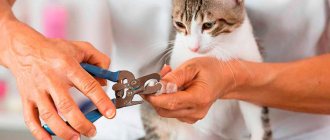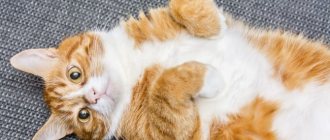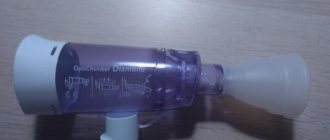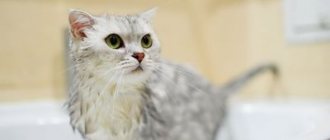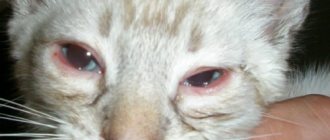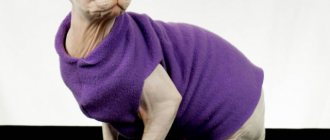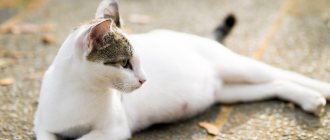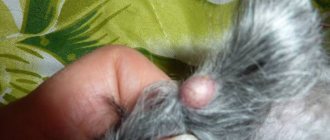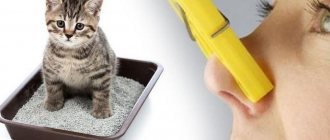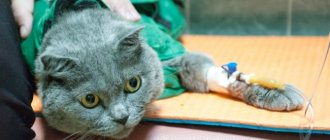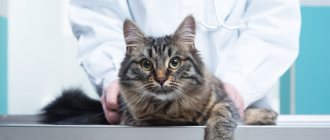Cat declawing surgery - onychectomy
Most owners are faced with the fact that sooner or later there comes a time when their pet injures them with sharp claws for various reasons. In such situations, the animal's nails should be trimmed. However, such manipulations will need to be carried out constantly.
There is a special procedure for declawing cats - onychectomy (soft paw surgery). This is a surgical removal with which the claw phalanges are completely amputated. This removal method allows you to permanently tear out the claws with the first phalanx of the toe on the animal’s front paws.
Reviews from veterinarians and pet owners
Experienced veterinarians advise not to declaw your pets unless there is a medical indication for it, as this operation can cause a large number of consequences that the animal owner will have to face.
In European countries, this procedure is strictly prohibited and is considered animal cruelty.
Harness for cats: tips on how to buy and properly dress a cat. Beautiful collars and features of training a cat to use a collar (105 photos)Automatic cat feeder - types, tips for choosing and comparison of the best feeders of 2021 (110 photos and videos)
How to train a kitten to use a litter box - correctly, quickly and easily train a cat to use a litter box (125 photos)
Pet owners still leave positive reviews about declawing cats:
- Furniture and wallpaper are not damaged;
- You don't have to be afraid to play with your pet.
But there are also a lot of negative reviews:
- Difficult recovery process;
- Constant postoperative care is required;
- The cat stopped going to the litter box;
- Deterioration of the cat's behavior;
- The emergence of health problems.
After numerous surveys of owners who had their pet declawed, 75% regretted it.
Consequences of surgery and the importance of claws in the life of cats
We must not forget that various changes can occur in a cat’s body after declawing through surgery. Possible consequences and complications after surgery:
- Inflammatory processes occurring in soft tissues.
- Long rehabilitation process.
- Change in movement coordination. The animal will only use its paws to grab objects, but will not be able to normally jump onto furniture or any surfaces. She will also lose the ability to defend herself.
- Negative reaction to anesthesia.
- Ignoring the tray.
- Psychological stress that will affect the cat's life.
- Severe pain in the suture area. Because of this, it is necessary to properly maintain the animal’s condition after surgery and not allow it to overexert itself.
Only an experienced veterinarian should perform declawing surgery. Otherwise, you can seriously harm the animal.
That scary word "onychectomy"
Onychectomy (translated as “claw resection”) is a surgical operation of moderate complexity and is performed under general anesthesia. Claws are removed in case of urgent need for everyone who has them: predators, rodents, amphibians, reptiles, birds.
But this surgical procedure is most famous in relation to cats, whose owners seek to simplify their coexistence with their pets in this way. They must realize: onychectomy is by no means a harmless manicure; Together with the claws, the animal has to cut off the upper phalanges of the fingers. The operation - even if it is not performed on all four legs, but only on the front legs - is fraught with serious health and mental problems for the cat.
This is what this operation would look like on your rollers
Operation Soft Paws
In the price lists of veterinary clinics, this cruel operation is carried out under the delicate name “Soft Paws”, and its cost varies from one and a half to six thousand rubles. Caring owners are ready to shell out a considerable amount of money to once and for all wean their “darling” from scratching and damaging furniture. I would like to hope that in this case people simply do not suspect what kind of torment they are dooming their pets to, and decide to turn them into helpless soft toys.
In most European countries, onychectomy for non-medical reasons is officially prohibited and amounts to cruelty to animals. Russian felinological organizations are also in favor of banning this operation, and operated cats are not allowed to participate in exhibitions because they are considered disabled.
To delete or not to delete - video
Indications
Sufficient medical indications for onychectomy include claw injuries or diseases that may pose a threat to the health or even life of the animal. In exceptional cases, an animal’s pathological aggressiveness, directed, for example, at a small child, is considered a sufficient argument for surgery.
Understand the reasons for your cat's aggression before calling it pathological
Everything else is solely the whim of the owners who do not want to spend a little time raising their pet and fully arranging its life and leisure time. The veterinarian must inform the cat's owner in detail about the essence and possible consequences of the operation and what could be an alternative to it.
Procedure
Declawing surgery can last from forty minutes to an hour . During this time, you will need a considerable dose of drugs for general anesthesia, which in itself is dangerous for the cat.
The claw is amputated along with a piece of the finger
The essence of the operation itself is simple and cynical - it consists of amputation of the claw phalanx, which is absolutely comparable to the removal of the upper phalanx of a human finger.
Risks and complications
As with any surgical intervention, a lot depends on the qualifications and experience of the doctor. The most common postoperative problems include:
- severe bleeding at the amputation site - not all veterinarians use coagulators to quickly and reliably stop the bleeding;
- ingrown claw - appears when the phalanx is removed incorrectly and requires repeated surgery;
- infection and abscess are very common and dangerous complications that can be fatal;
- osteomyelitis - severe purulent lesion and necrosis of bone tissue;
- circulatory disorders are problems of the postoperative period, arising from bandaging the paws too tightly.
Complications after declawing can lead to complete removal of the paw
Rehabilitation
The recovery process after surgery can take quite a long time, and during this time the animal will experience severe pain. The cat will not be able to walk independently for five to seven days. In a normal, uncomplicated course of the rehabilitation process, it will take at least a month. During this time you will need:
- keep the cat in a special plastic collar to prevent it from licking its paws;
- regularly administer pain-relieving injections as prescribed by your doctor;
- change sterile dressings and treat wounds daily.
A cat will have a very long and difficult recovery after surgery.
Even if you are able to perform all the manipulations yourself, you should show the operated animal to the veterinarian at least once every three days - so as not to miss the beginning of the development of any dangerous process.
It is important to insure your pet’s movements for at least another one and a half to two months to protect it from injury. Until the cat is able to adapt to the new state of its paws, any previously usual jump can be dangerous for it.
A regular jump after surgery can result in injury
Consequences
Errors during surgery can permanently disrupt the animal's normal gait and natural balance of movements. Your cat will have to learn to walk again—literally. Even if the cat can move more or less normally, the load on its muscles and joints will no longer be optimal, which in the vast majority of cases leads to arthritis, overload of some muscles and atrophy of others.
Until the end of its life, an operated animal cannot be left unattended, even for a short time, even in the home yard - now the cat is surrounded everywhere by dangers that it cannot cope with on its own.
The operation will bring not only physical but also mental suffering to the animal.
In addition to the negative physical consequences of the operation, there are also important psychological ones. Severe and prolonged pain in the limbs is stress for the animal, which can result in permanent depression for it. Awareness of one's defenselessness causes great moral trauma to the animal. As a result, her character may radically change for the worse. Cats often become unmotivatedly aggressive and use their sharp teeth to compensate for the loss of claws.
Even a well-trained animal often refuses to use it. Perhaps, without claws, it is now painful and uncomfortable for him to rake the litter in the tray with his paws. But there is also a possibility that the cat is taking revenge on its owner for an insult by defecating all over the house.
Don't make a cat disabled - video
There is an alternative: anti-scratch and scratching posts
There are many simple and safe ways to stop a cat from scratching its owner’s hands, wallpaper and furniture. It is best to start doing this while the kitten is still very small - gradually growing up, he will begin to perceive the rules of behavior and hygiene procedures as something completely natural. Then your life together will be mutually comfortable, without casualties, destruction and other troubles.
Teaching a cat not to scratch in vain - photo gallery
Education from a young age - it needs to start from the first minutes of a kitten’s stay in the house
Cats usually like scratching posts much more than upholstered furniture and wallpaper.
False anti-scratch claws - a simple solution to complex problems
Active games and toys will distract the animal
Regular nail trimming should become a mandatory hygiene procedure.
Chemical treatment of “risk zones” with special preparations will deprive the cat of the desire to open its claws here
Anti-vandal coatings of modern upholstered furniture are designed to withstand sharp cat claws
Scratching posts and other things
Pet stores offer such a wide selection of different scratching posts that it is usually difficult to settle on just one. In the image and likeness of ready-made models, you can build a scratching post with your own hands.
Find a good place for the scratching post
It doesn’t have to be something glamorous at all - often a cat is completely delighted with a piece of the most ordinary bark fixed in a convenient place, and simply ignores the expensive “sophisticated” design.
It is important to find a good place for the scratching post, and this can only be done empirically - by trial and error . Cats like to clean their claws in cozy places, so try placing scratching posts in the corners of rooms, diverting the cat's attention from upholstered furniture. In order for the animal to quickly deign to pay attention to your efforts, treat the new scratching post with something pleasantly smelling, for example, catnip or valerian - the process of adaptation will go much faster.
Advantages and disadvantages of soft paw surgery
If owners don't know how to protect themselves and their furniture from scratches, it's important to learn the pros and cons of cat declawing. Depending on this, you can make the right decision regarding the operation. Benefits of declawing:
- The pet will no longer scratch household members and damage furniture.
- If the claws are pulled out, there will be no need to install scratching posts indoors.
- With the right rehabilitation process, the animal will be able to return to normal life within a week.
Disadvantages of surgical removal:
- The stressful situation of the animal after surgery can disrupt the usual lifestyle of all household members.
- There is a high risk of developing various complications after surgery.
- The cat will begin to learn to walk again.
- An animal without claws will not survive on the street.
There are many more disadvantages to this procedure than advantages. Therefore, you need to weigh the pros and cons.
Feedback from pet owners
Vita Trushechkina
But I no longer doubt it. I already decided, today, after the cats went crazy, ran around like crazy and scratched our 9 month old daughter who was sitting playing on the floor. I'm not even talking about how scared she was. And yesterday I saw how one of the cats wanted to hit my daughter, but saw me and ran away. So I won't wait for them to claw her eyes out. I love our cats, but the child and his safety are more important.
Svetlana Skibenko
I'm sorry, but why are we talking only about sofas? Let's talk about the hostess's health! My cat is very affectionate and peaceful, he has been in our family since two months and has seen only tenderness - he is our favorite. But sometimes he has attacks of aggression or fear (for example, he was afraid of a working food processor) - he attacks me, his mistress. He has already repeatedly torn my legs to pieces, a couple of times even the ambulance took me away. The doctors advised me to get rid of the cat, but, again, I love him very much and don’t want to part with him. But I am still constantly afraid of his attacks. My legs are covered in terrible scars and in the summer I can’t even go to the beach! Moreover, this threatens blood poisoning. So what should I do - sacrifice the cat or is it better to use his claws?!
Jennifer
We declawed our cat. And it was a damn good decision. While all the wallpaper in our house was torn, shreds of carpets flew in all directions, etc. I endured it, trimmed the cat’s claws, ran after him with a scratching post, and so on. He sneezed on me and all my efforts. But when he with his claws jumped onto the hanger where my expensive leather jacket from Italy and my husband’s equally expensive sheepskin coat were hanging…. and, clinging to the jacket with one paw and the sheepskin coat with the other, he slid down, tearing shreds out of our clothes - this was the last straw. He was given general anesthesia and only the claws on his front paws were carefully removed. A week later he was jumping around like a saiga.
